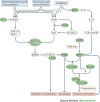Immune mediators in the brain and peripheral tissues in autism spectrum disorder
- PMID: 26189694
- PMCID: PMC5650494
- DOI: 10.1038/nrn3978
Immune mediators in the brain and peripheral tissues in autism spectrum disorder
Abstract
Increasing evidence points to a central role for immune dysregulation in autism spectrum disorder (ASD). Several ASD risk genes encode components of the immune system and many maternal immune system-related risk factors--including autoimmunity, infection and fetal reactive antibodies--are associated with ASD. In addition, there is evidence of ongoing immune dysregulation in individuals with ASD and in animal models of this disorder. Recently, several molecular signalling pathways--including pathways downstream of cytokines, the receptor MET, major histocompatibility complex class I molecules, microglia and complement factors--have been identified that link immune activation to ASD phenotypes. Together, these findings indicate that the immune system is a point of convergence for multiple ASD-related genetic and environmental risk factors.
Conflict of interest statement
Figures



References
-
- CDC. Prevalence of Autism Spectrum Disorder Among Children Aged 8 Years--Autism and Developmental Disabilities Monitoring Network, 11 Sites, United States, 2010. In: Baio J, editor. Morbidity and Mortality Weekly Report. Vol. 63. Naitonal Center on Birth Defects and Developmental Disabilities, CDC; 2014. pp. 1–21. - PubMed
-
- Rosenberg RE, et al. Characteristics and concordance of autism spectrum disorders among 277 twin pairs. Arch Pediatr Adolesc Med. 2009;163:907–914. - PubMed
Publication types
MeSH terms
Grants and funding
LinkOut - more resources
Full Text Sources
Other Literature Sources
Miscellaneous

